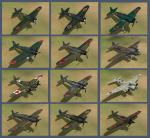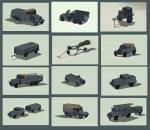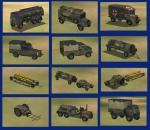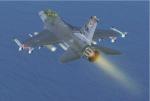All Files > Page 8

Japanese_static_aircraft
(Category: CFS2 > Scenery)
13.23Mb (24 downloads)
Japanese static aircraft
This is a dozen static Japanese aircraft ground objects.
They are converted from the original CFS2 models into SCENEDB/inf .bgl files which can be placed in the game with the Mission Builder. They use the same texture files as the original models so you can change the textures with any different options for the same aircraft that may be available.
They have damage models and are destroyable.
Conversions by Captain Kurt
The planes and credits are:
A6M2 Zero: Stock OH Model by The B24Guy, texture by Captain Kurt
A6M5 Zero: Stock OH Model by The B24Guy, texture by Captain Kurt
N1K2 Oscar: Stock OH Model by The B24Guy texture same
B5N2 Kate:Stock OH Model by The B24Guy, texture by Uncle Tgt
D3A1 Val: Stock OH Model by The B24Guy, texture by Captain Kurt
G4M1 Betty: model by A.F.Scrub FS2004 conversion from Stuart Green, texture by Uncle Tgt
Ki.21 Sally: model by PAYAKAN, texture by Uncle Tgt
Ki.43 Oscar: Stock OH Model by The B24Guy, texture by Captain Kurt
Ki.45 Nick: model by Akemi, texture by same
Ki.61 Tony: model by Akemi, texture by Captain Kurt
Ki.84 Frank: model by Akemi, texture by Captain Kurt
Ki.100 Tony: model by Akemi, texture Morton
Collection by Captain Kurt
Posted Nov 16, 2025 16:52 by Captain Kurt

Luftwaffe_airfield_vehicles
(Category: CFS2 > Scenery)
1.70Mb (22 downloads)
This is a set of twelve WWII Luftwaffe airfield ground vehicles. These are not really intended as targets although they do have damage files. Rather they are intended to be viewed around the airfield from the player's aircraft. So, they are more detailed than the usual vehicle bgls. Therefore they have a bit larger file, but still not bad. I've put quite a few in a mission without affecting the frame rates.
Vehicles:
Ah B2/1 = towed fuel bowser
Hanomag_SS100 = heavy road and airfield tractor
Hanomag_tow = Hanomag tractor towing fuel bowser
Henschel_33D = most commonly used Luftwaffe medium truck
Krupp_Protze = personnel mover
Krupp_Protze_open = personnel mover without convertable canvas cover
Kubelwagen = Volkswagen version of a Jeep type car
Kubelwagen_top = Volkswagen version of a Jeep type car with a convertable canvas top
LW_bomb_ loader = manual hydraulic lift for loading a single bomb
LW_starter_cart = generator powered starter cart
MB_L1500S_fire = fire truck, water pressure pump was in the towed trailer
MB_LG3000_fuel = 3500 liter fuel tanker truck
Credits: Models and textures by Captain Kurt
Allen for his "FSDS make exploding object tools" without which I never would have figured out how to create these objects.
Nibbio for his vehicle dust effects
Posted Nov 16, 2025 16:48 by Captain Kurt

British_Airfield_Vehicles
(Category: CFS2 > Scenery)
2.14Mb (23 downloads)
This is a set of twelve WWII British airfield ground vehicles. These are not really intended as targets although they do have damage files. Rather they are intended to be viewed around the airfield from the player's aircraft. So, they are more detailed than the usual vehicle bgls. Therefore they have a bit larger file, but still not bad. I've put quite a few in a mission without affecting the frame rates.
Vehicles:
AEC_854 = "Matador" heavy tanker refueler
Albion_AM463 = tanker refueler 1938 to 1942 mainly, then gradually replaced with Bedford and AEC tankers
Austin_K2 = standard ambulanece
Austin_Tilly = light utility truck
Bedford_MWD = utility truck
bomb_trolley = C Type bomb trolley w/ 4x500lb bombs
Brockhouse_bowser = towed fuel tank refueler
Crossley_FE1 = fire / foam crash tender
DB_tug_trolley = David Brown tractor tug towing the bomb trolley
DBtug_bowser = David Brown tractor tug towing the Brockhouse bowser
Fordson_WOT8 = 3 ton lorry
starter_cart = electric battery cart used to provide power to start many RAF type aircraft.. Spits, Hurris etc.
Credits: Models and textures by Captain Kurt
Allen for his "FSDS make exploding object tools" without which I never would have figured out how to create these objects.
Nibbio for his vehicle dust effects
Posted Nov 16, 2025 16:44 by Captain Kurt

FSX/P3D Boeing 777F Atlas Air package.
(Category: FSX > Civil Jets)
86.92Mb (311 downloads)
FSX/P3D Boeing 777F Atlas Air package.
Based at White Plains, New York, Atlas Air currently operate 11 Boeing 777F aircraft although only 4 are painted in the Atlas livery. The others being leased from or operated for CMA CGM, YunExpress and MSC Cargo
Updated with new VC and more. Realistic CFM soundpack added.
Original VC by Jacob Kubique. Converted to FSX native by Zachary777.
VC updates by Speedbird77 with gauges by G. Munro and Ken Wiggington.
See Credits for more.
Textured and assembled by Chris Evans.
Posted Nov 15, 2025 15:50 by chris evans

FSX/P3d Airbus A320-232 H4-SIB Solomon Airlines
(Category: FSX > Civil Jets)
56.15Mb (132 downloads)
MSN 2445 was built in 2005 and flight tested as F-WWBS, before being delivered to Freedom Air in June 2005, as ZK-OJK, leased from Air New Zealand. She then went to TAM as PR-MBJ, before being restored to Air New Zealand as ZK-OJK in May 2012. In November 2019 she was stored, before being sold to a leasing company, who then leased her to Solomon Airlines, in March 2020, with whom she continues in service.
Painted on to the Project Airbus A320-IAE-200 model, this shows H4-SIB as she is in service with Solomon Airlines, at this time. 2d panel but NO VC.
Posted Nov 14, 2025 13:45 by Steve Morley

Update for FSX of the F-16D Edwards
(Category: FSX > Military)
45.66Mb (175 downloads)
This is an update of the F-16D by Kirk Olsson, repainted by SJ Avila. Rather than combine this paint with the original aircraft, I thought some might want a clean stand alone aircraft with a good paint job. Only the empty model was used along with the sound from the original aircraft. I added a panel that I liked and SJ's textures. Any contact points that needed it were corrected; and I updated the flight dynamics.
Posted Nov 13, 2025 22:01 by Bob Chicilo

Update for FSX of the F-16D
(Category: FSX > Military)
66.20Mb (286 downloads)
This is an update for FSX of the F-16D by KIRK OLSSON. I have fixed the hole in the 2D panel and removed the smudge from the upper left corner of the window; I have added an autopilot, fuel gauge and nav/GPS switch in a window; changed the GPS size and position and made the GPS icon work; removed the smoke that I don't know why it was there; added an afterburner; and updated the flight dynamics.
Posted Nov 13, 2025 14:42 by Bob Chicilo

FSX/P3D Canadian Airlines Boeing 757-300ER
(Category: FSX > Civil Jets)
135.40Mb (170 downloads)
This is a repaint for the amazing TDS Boeing 757-300. It includes the base model, high-quality textures, custom Canadian Airlines ground services, and a VC.
Canadian Airlines has never flown the 757 in any variant. This makes sense, as the 757 major target market was high-density short and mid-range domestic routes, shuttle services, and transcontinental U.S. flights. Dubbed "the flying pencil" due to it's long and skinny fuselage, the 757-300 is the longest single aisle airliner of it's time. Powered by 2 Rolls-Royce RB211-535-E4(B) engines, this new Canadian Airlines 757-300 is now available to fly any route of your choice.
Includes:
- Base Model Boeing 757-300 aircraft by TDS
- Textures for Canadian Airlines livery.
- Canadian Airlines Boeing 757-300 C-GCBJ
- Full working VC
- Custom Canadian Airlines Cargo baggage carts
- Custom Canadian Airlines Cargo baggage handlers
- Custom Shell VIP Jet fuel service trucks
- Custom Canadian Airlines AirStairs
- Custom Gate Gourmet catering service vehicles
*****************
WINGLET VERSION
*****************
This repaint comes with 3 versions: Winglet, flared wingtips, and no wingtips. The default is the flared winglet version. In order to change to the Winglet version, open the aircraft.cfg file, and change the "model=" to read "model=w1" or "model=w2". That's it! Your aircraft should now have winglets. If you do not want winglets, please enter "model=". If you don't know what you're doing, don't change the aircraft.cfg file.
Posted Nov 12, 2025 08:26 by Julian Flight

FSX/P3D Airbus A320NEO China Eastern package
(Category: FSX > Civil Jets)
77.27Mb (199 downloads)
FSX/P3D Airbus A320NEO China Eastern package. Currently China Eastern operate 120 Airbus A320NEO's to and flies to destinations around Asia, Europe and the USA.
Model by Project Airbus with NEO engine mod by Bret Herman. Updated VC by Speedbird77 with built in FMC by Garret Smith. Includes A320 operation manual and checklist. CFM NEO sounds included. Textured, assembled for P3D v5.4 by Chris Evans. Should work in FSX and other P3D
Posted Nov 12, 2025 02:21 by chris evans

FSX/P3D Air Canada Boeing 757-300
(Category: FSX > Civil Jets)
134.96Mb (175 downloads)
This is a repaint for the amazing TDS Boeing 757-300. It includes the base model, high-quality textures, custom Air Canada ground services, and a VC.
Air Canada has never flown the 757 in any variant. This makes sense, as the 757 major target market was high-density short and mid-range domestic routes, shuttle services, and transcontinental U.S. flights. Dubbed "the flying pencil" due to it's long and skinny fuselage, the 757-300 is the longest single aisle airliner of it's time. Powered by 2 Rolls-Royce RB211-535-E4(B) engines, this new Air Canada 757-300 is now available to fly any route of your choice.
Includes:
---------
- Base Model Boeing 757-300 aircraft by TDS
- Textures for Air Canada livery.
- Air Canada Boeing 757-300 C-RTCB
- Full working VC
- Custom Air Canada Cargo baggage carts
- Custom Air Canada Cargo baggage handlers
- Custom Shell VIP Jet fuel service trucks
- Custom Air Canada AirStairs
- Custom Gate Gourmet catering service vehicles
*******************
*WINGLET VERSION*
*******************
This repaint comes with 3 versions: Winglet, flared wingtips, and no wingtips. The default is the flared winglet version. In order to change to the Winglet version, open the aircraft.cfg file, and change the "model=" to read "model=w1" or "model=w2". That's it! Your aircraft should now have winglets. If you do not want winglets, please enter "model=". If you don't know what you're doing, don't change the aircraft.cfg file.
Posted Nov 11, 2025 06:18 by Julian Flight








